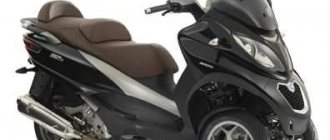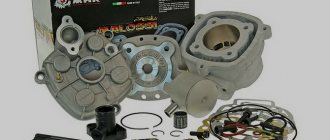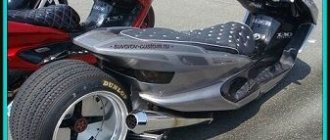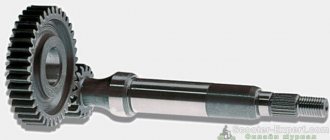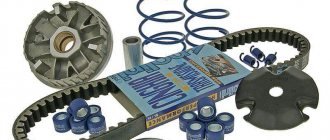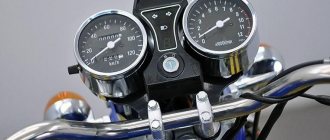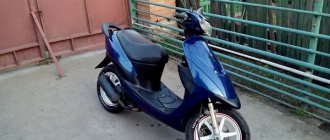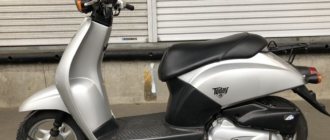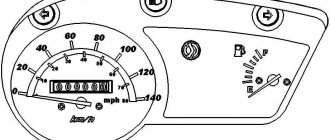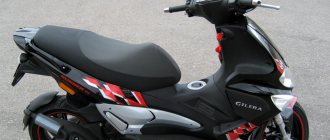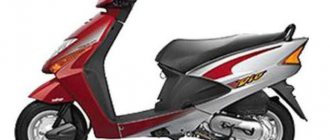Ahead of the 2021 model year, Piaggio has redesigned its Typhoon 50. The 2021 scooter has undergone significant changes and is now truly brand new. New body panels only slightly changed the recognizable appearance of the Typhoon. Now the heart of the scooter is a new two-stroke engine, the exhaust system of which has been rebuilt to meet the Euro4 standard. The company plans to bring this baby to the US market in the segment of scooters for teenagers and novice riders. Let's see what the Italian manufacturer offers.
Piaggio MP3 Hybrid
Piaggio MP3 Hybrid
Piaggio MP3 Hybrid
“Make me a miracle,” the buyer capriciously demands. And that’s all the manufacturer needs, especially if the miracle is already standing in the bushes - sorry, on the exhibition podium and is getting ready to go on the conveyor belt. How would you like a scooter with the performance of a 250cc car, but at the same time using half as much gas? Like? Welcome to Piaggio dealers.
Typhoon 50 chassis.
Dual tires can handle soft conditions, but they are still designed for driving on asphalt. The tires are mounted on alloy wheels with a diameter of 12 inches, quite typical for a scooter of this volume. They do not improve the handling of the Typhoon. Just regular discs. The half-duplex steel frame is connected to a telescopic fork at the front. An adjustable shock absorber supports the rear and also controls the movement of the swingarm. The rear wheel is stopped by a 140mm drum brake. The front wheel is equipped with a 220 mm disc brake and a modern hydraulic caliper. You won't find ABS here, but that's not surprising. The wheelbase is 135 cm, the height is 77 cm. So, driving this scooter will only be uncomfortable for people of very short stature.
Piaggio MP3 Hybrid
The HY tech button on the right handlebar controls mode switching.
On the left is an additional signal button that warns other road users when driving on electric power. The HY tech button on the right handlebar controls mode switching. On the left is an additional signal button that warns other road users when driving on electric power.
So far, only hybrid technology is really capable of such a trick - “ICE + electric motor”, the synchronous operation of which is ensured by electronics. The hybrid installation of the Piaggio MP3 Hybrid is of a parallel type: there is no rigid “coupling” between the internal combustion engine and the electric motor; their efforts are summed up in the transmission. The working volume of the internal combustion engine is only 125 cm³, the maximum power is 15 hp. The electric motor develops only 3.5 hp, and at first glance it is not clear where the promised 85 percent increase in dynamics comes from when both units work together. But compare the torque: 16 Nm for the gasoline engine and 15 Nm for the electric motor. This is where the 125 cc machine has the acceleration dynamics of a 250 cc machine! Of course, only in the first hundred meters, but in city traffic this is what is important.
Review from Dred: tuning my Piaggio NRG 50cc scooter
Many people have questions about why the manufacturers themselves don’t make normal “unclamped” and powerful high-speed cars. After all, for example, out of 50 cubic meters, tuners squeeze up to 14 forces! The fact is that mass-produced scooters are not designed for racing, but for getting around the city. And even if they say that there are off-road scooters, this is not all that. It's like off-road Mercedes for 400 horsepower, which cost an exorbitant amount, but has anyone seen how these cars sat up to their ears in shit or climbed through swamps?
The same goes for scooters. Manufacturers focus on the broad masses of consumers. The scooter should also be unpretentious in maintenance and its service life should be more or less high. Imagine how moms and dads would respond to manufacturers if their kids rode scooters at 90-110 km/h and sometimes fell a little? Or the reaction of housewives and pensioners who got on a scooter to get to the store, receiving instead of a sluggish acceleration a shot from under the butts and a somersault of the car in the air?
And is it necessary to convince anyone that a car loaded to the brim not only requires expensive synthetic oils, 98 gasoline and constant maintenance, but also consumes fuel like a small car (5-8 liters per 100 km), and besides, it roars like baker custom. But stop! We were talking only about “evilly charged” scooters. Let's consider options for step-by-step tuning. I don’t want to write about any possible options.
I will describe to you the specific tuning of my Piaggio NRG.
To tell the truth, this model drove quite well even before tuning. 90-100 km/h in a straight line. True according to the standard speedometer. In reality, as it turned out later, he is lying at 5-7 km/h, exaggerating the speed. At first everything was enough for me, but then I, like one scalded, began to tune my beast. The acceleration characteristics did not suit me. I wanted more.
Stage 1
Exhaust pipe Polini Funky
Purchased a 70cc cylinder (Polini Base 9.8 hp) + silencer (Polini Funky).
What to say? $340 for hardware? Can you buy a scooter for that amount? Nonsense?
In short, there were a lot of impressions. From a standstill the scooter began to tear up very quickly. When accelerating to 60 km/h, the scooter reduced the time by 1.5-2 seconds. Thanks to the muffler, the maximum speed has been increased. The engine began to breathe easier. Fuel consumption has remained virtually unchanged!!! In principle, for beginners this option can be considered sufficient. The scooter, however, became louder, but very tolerable. The service life of the new cylinder is not much less than the standard one and the consumption of the expensive 95 has not increased. To put it even simpler, owners of “sports” mufflers (a muffler with an expansion chamber and a resonator at the end) don’t have to bother tuning the muffler at all.
Why? No, of course, Polini Funky will work better than a standard (even “sports”) jammer, but you won’t feel it for 170 bucks. Let me explain: there will be an increase, but not that significant. For example, if you change the muffler on a regular Sepia or Jog to a tuning one, it will be more noticeable than, for example, replacing the muffler on the same Sepia-ZZ.
There is also the problem of weak suspension of small scooters. The speed increases, but the weakness of the frame remains the same. Some people don't care about this, but it's worth thinking about. The Japanese are not scoops and will not make a 2- or 3-fold safety margin. Everything should have its weight and price and exactly as much as it is needed. Okay, let's continue. A bumpy road can be fatal. Remember that they are also coming for you, and not scooters, but all sorts of Mazas and Belazs.
What to do? In a good way, it is necessary to strengthen the suspension, weld reinforcement gussets into the frame, and change the silent blocks. But this is not mentioned in the tuning kits. In practice, everyone doesn’t do this and drive as is. And nothing, they drive.
Nevermind. Even by charging your scooter with only a 70cc cylinder, you can safely feel the full power and superiority of your device over the standard one. The only problem here may be a broken crankshaft. It is almost impossible to determine 100% the condition of the crankshaft. For example, how can you see internal cracks in metal? But it is possible to get a rough picture. True, for this you need to remove at least the piston. If the “knee” of your scooter is averagely lousy, then you should refrain from forcing the engine or change the knee.
Stage 2
After installing the pot and pipe, I found out that there are still some necessary parts for tuning. Then it started: a 21 mm carburetor, an intake “house” with carbon petals, an air filter, electric. ignition control unit, silent blocks, rear shock absorber, variator belt, variator spring, variator pulley with weights. Jets, etc. little things.
Carburetor DellOrto PHBG 21mm
As a result, we managed to accelerate the engine quite well. The craving is just crazy. Speed: more than 120 km/h I’m simply afraid to accelerate, although I feel that the engine can continue to spin. The carburetor gave the scooter even more maximum speed and improved reception. There were difficulties installing a new filter. Its intake resistance was so small that the mixture was very lean. After a very long ordeal, I installed the required jet and everything fell into place.
Set of jets for carburetor DellOrto PHBG 21mm
Email I bought the block to satisfy my vanity. Although he is expensive at $120, he knows his stuff. The traction at the top is simply colossal. The engine responds to the throttle after 70-80 km/h almost like at the beginning of acceleration. Salenblocks eliminated the bumpiness of the rear suspension. The shock absorber is simply a miracle. At the beginning I had a weak “Agazik”, and even with adjustable spring preload.
As a result, the rear suspension stopped piercing and began to simply “stick” to the road. In operation it’s also a plus: if you’re driving alone, you’ll turn it looser, but with a passenger you’ll turn it harder. Fortunately, the process of “winding up” the spring does not take much time.
Next came the variator. Its correct setting has many subtleties and nuances. The main task of the variator is to ensure that the engine speed is close to its peak power during the acceleration period of the scooter. Those. if they write 6 forces at 6500 rpm, then this means that the maximum engine power will be only at 6500 rpm. And the task of the variator is to maintain these speeds, gradually loading the engine. This feature of the scooter allows it to outperform mopeds with a gearbox. Not a single 50 cc “sportbike” can match a properly tuned (variable speed) scooter with its six speeds.
But the driven pulley of the variator is half the battle. The load on the belt increases and it begins to slip. To fix this, you will have to change the rear spring to a stiffer one. True, this is not a pleasant matter. You will have to unscrew the clutch and remove the driven pulleys. Installing a new belt is justified if the standard one wears out, although you can buy a spare.
Malossi X-Special variator belt
What came of it all? Hard to say. More than a scooter, but less than a motorcycle. Max. speed: (according to car speedometer) 120 km/h, fuel consumption (ai 95): on the highway at 90 km/h 4.5 liters per 100 km, in the city 5.5-6 liters. per 100 km
Cost of tuning in Moscow without installation cost (all units “Polini” or “Malossi” for the Piaggio NER G model):
- Cylinder 68cc Base 9.8 HP $170 or 68cc Corsa 12.5 hp $210
- Muffler “Funky” $170
- Carburetor 21 mm + filter $120
- Inlet “house” $40
- Salent blocks “Polini” 2 pcs. 10 USD
- Ignition control unit $120
- Variator belt $25
- Driven pulley springs $10
- CVT drive pulley with weights $60
- Rear shock absorber “Paioli” $120
Total, not counting the Corsa, seems to be $845. A very large amount. The consolation is that it was not spent immediately, but gradually over two years. Every time you purchase a new one, you find something new in the scooter. In principle, if I weren’t such a fan of scooter hardware and racing, I would never have spent that amount of money. I presented this list not for foppishness or coolness. Just look at what tuning in Moscow actually costs for a “liquid” Italian. But this amount, I emphasize, is without installation and configuration, i.e. price of iron. And here we can add new brakes and clutch, but I’ll probably put that off for now.
So. I dare to evaluate all the pros and cons of tuning.
Stage 1
As I already said, with a successful combination of circumstances, you can get by with little bloodshed, i.e. change only the piston and leave the muffler alone for now (if it looks like a sports muffler as standard). Next, if you are tinkering with carbs and jets, you can play with these same jets in the carburetor. Before doing this, remove everything in the filter box that in your opinion interferes with the air supply. The main thing in this matter is not to overdo it. The inlet hole in the filter box must be no smaller than the hole in the carburetor. Even in this form, the scooter will change.
Increase everything: speed, dynamics, and traction. What else is tempting? The car remains more or less calm and flexible. The engine pulls and can move slowly. If fuel consumption increases, it is not very much, by about 0.2-1 liters. per 100 km. The engine resource in this boost stage is reduced, of course, but this is practically unnoticeable.
And the downside is that THERE ARE STILL DEVIL REMAINING THAT MAKE ME WITH THE LIGHT FORRRRAA!!!
Stage 2
To tell the truth, further boost is more suitable for racing than for traveling around the city. The fact is that that minimal tuning did not reveal the full power of the engine. Leaving the standard carburetor and filter, you still muffle the engine, but...
Driving around the city in traffic jams with a 21 mm carb filter and a properly tuned variator from the same Polini is very difficult and stressful. The fact is that due to the improved throughput of the carb, the filling of the cylinder with the fuel mixture improves, and as a result of this, the engine simply explodes and spins wildly. And a properly configured variator helps him with this.
At the beginning of the spin-up, the variator hardly loads the engine, and when the engine howls to 7000-8000 thousand rpm. This is where the pickup begins. Moreover, the engine loses all desire to operate at low speeds. Forget about driving at a speed of 15-30 km/h; sometimes it is difficult to catch a low knee speed with the throttle. And sometimes in traffic jams you need to move in this mode. And having tuned the scooter in stage 2, you have to constantly accelerate and brake, and this hassle is practically untreatable.
Moreover, another disadvantage can be considered the new filter, i.e. its sound! The standard one is placed in a box, which is not only a filter holder, but also a muffler for the intake tract. By installing a new filter, we deprive the scooter of this muffler and get an almost deafening sound when accelerating. In a city where you often have to accelerate and brake, this is annoying. After riding for an hour, my head becomes heavy and everything strains me. But from a standstill the moped shoots like crazy. And if a deafening roar is the thing for you, then go!
What are the disadvantages here? There are plenty of disadvantages here. One thing is that the engine eats your wallet. 5-6 liters 95 per 100 km. around town!!! Cool. The roar of the engine is a muffler + carburetor, I don’t know if this is a minus or a plus for everyone. For me it's a minus. In racing this is one thing, but in the city growling so that you can be heard 1 km away is too much.
But all this fades before you leave the traffic light. Not only do you have to lay down quite a bit on the steering wheel so as not to become a jerk, but even then the rear wheel starts to slip! There are no competitors in acceleration from 0 to 60-70! I mean cars. Maybe, with rare exceptions, the driver will squeal after you and catch up with you, but this is rare.
In principle, this boost is the optimal power for a city scooter. The engine power is enough for sharp accelerations and for driving at speeds of 70-90. In this speed range (frequent for Moscow) there is a reserve of power for overtaking or changing lanes. And if it were not for the noise and fuel consumption, then it would be worth it. And the engine resource with such boost decreases. How much? Nobody will tell you the exact data. There are too many reasons on which these data depend. And the quality of the fuel and oil being poured, and the frequency of maintenance, etc.
I will say that I heard that supposedly on the Corse it is necessary every 2000-3000 km. change rings. I can’t say for sure; I haven’t changed it yet. That's all it seems now. I’ll write as soon as there’s anything new.
© Dred
© 2021 Alexander Smirnov, gilerarunner.ru. Spare parts and accessories for Italian motorcycles from Europe.
Phone/WhatsApp or email The email address is protected from spambots. Javascript must be enabled in your browser to view the address.
Piaggio MP3 Hybrid
The battery can also be recharged from an external source.
The battery can also be recharged from an external source.
The throttle valve drive is “by wire”: with the throttle handle the driver only “indicates his desires”, and the computer executes the command, connecting the internal combustion engine, the electric motor, or both at once. The Hybrid's most interesting control is the magical four-way switch. It allows you to choose one of three forward driving modes: only on electric power (relevant in some European cities, where only cars with “zero emission” are allowed to enter the center; range is up to 20 km), combined with dynamics priority, combined with charging priority , or reverse (electrically driven). The battery charge indicator on the dashboard helps in choosing a mode. Moreover, the Piaggio MP3 Hybrid is the world’s first car with a hybrid drive, in which the battery (the most modern, lithium-ion) is charged not only while driving (including through energy recovery during braking), but also when parked, from a normal sockets The full charging time is three hours, but the battery reaches 85% of its capacity in two hours.
Design.
Piaggio retained the most recognizable feature of the Typhoon family - the sharp nose. The familiar look is complemented by a dual headlamp design with four vents on each side. Gold-colored brake calipers peek through the completely black rims. This color scheme is supported by the front fairing and forks. One of the goals of Typhoon scooters is to attract attention to the driver. For this purpose, there are stylish stickers that support the sporty design. The 2021 generation is no exception. The stickers fit well on the body panels. But it is doubtful that they were really needed, because the bike simply does not have large areas that need to be visually divided. But at least Typhoon looks less official. Behind the typically Italian steering wheel you can see a dashboard with an analogue clock and speedometer, LCD screen and other indicators. There is no tachometer, but there is a fuel gauge and there is no need to rely on the odometer. There is a flat floor under the driver's feet—there is no tunnel, so boarding and disembarking occurs without any hitches. The new seat is covered in smooth fabric. If you fold it back, the luggage compartment opens, in which an integral helmet can fit. There is also a USB connector, so you can also charge your gadgets on the go. The subframe is raised slightly and forms the rear seat. The passenger will be comfortable, because there are footrests and a handrail. The rear view is completed by an LED taillight, mudguard and license plate surround. The new muffler casing slightly changed the appearance of the power plant. Overall, Typhoon is, as usual, a special embodiment of youth enthusiasm.
Piaggio MP3 Hybrid
Although the battery and electronics units take up the entire seat space, there is still a helmet rack at the rear.
Although the battery and electronics units take up the entire seat space, there is still a helmet rack at the rear.
What does such a sophisticated scheme achieve? Look at the table. Of course, this is “branded”, that is, largely advertising data. Nevertheless…
Some details about Piaggio 1
The Piaggio 1 comes in six color options, and the Forever White we tested turned out to be surprisingly well-made, high-quality, and pretty. White scooters often look downright pale, but the white trim elements of the Piaggio 1 contrast very well with the black glossy wheels, the dashboard frame, the inside of the front shield, and the wing of an interesting design. Small relief details on the surface of the cladding give it a finished look, and the LED light with DRLs of an interesting shape and built-in turn signals emphasize that the design of the scooter is not tied to any one era.
The full-color information panel has several layout configurations, including a single-color day mode and a colorful night mode, which changes automatically depending on the brightness of the surrounding lighting. The dashboard is pleasing to the eye and informative, although there are not as many important parameters on the electric scooter as on models with internal combustion engines.
The scooter is equipped with a USB socket, a traditional European luggage hook for shopping bags, and the underseat space, unexpectedly for an electric model, has free luggage capacity not occupied by the battery. The battery is there, but located deep in the frame, and can be removed for charging at home (which takes six hours) or charged without removal. The charger is placed nearby, along with an anti-theft chain and a rain cape, and an open helmet can also fit into the empty compartment.
Other color options include Forever Black, Forever Grey, Sunshine Mix, Blue and White Arctic Mix and Forest Mix. Traditionally for Piaggio, the lining can be removed quite easily, and third-party manufacturers will certainly soon offer additional color and design options.
Electric scooter Piaggio 1
Piaggio MP3 Hybrid
Of course, there are no free miracles. If the “simple” 250 cc Piaggio MP3 costs 6,000 euros in Italy, then the expected price for the MP3 Hybrid is 10,000 euros. Such a difference in cost will not pay off soon. However, now “hybrids” are bought not so much for the sake of savings, but as a kind of “ecological show-off”. It is not for nothing that in the automotive world, among the leaders in hybridization are such luxury brands as Lexus, BMW and Mercedes-Benz.
Piaggio 1 in the city
In the scooter's natural habitat - city streets - you quickly realize that the electric riding modes are actually useful, even if the top speed is limited to 60km/h.
Eco mode is obviously designed to save energy, and it limits power slightly. In this mode, the scooter reaches up to 30 km/h, and this is quite enough for a quiet ride in traffic. With a press of a button on the right remote, it switches to Sport mode, where full power is available, but at the cost of range. Of course, most riders will prefer this mode. The convenient reverse function (at a snail's pace, of course) makes maneuvering in parking lots easier, and the near-silent ride creates a fun feeling of calm that has little in common with vigorously riding a motorcycle with a loud exhaust.
Piaggio MP3 Hybrid
Piaggio MP3 Hybrid - the most advanced hybrid scooter available now.
Piaggio MP3 Hybrid - the most advanced hybrid scooter available now.
At the same time, the concern is slowly improving its “regular” products. Thus, Vespa scooters of the LX and S series this summer received two-valve “air vents” (125 and 150 cm³) with fuel injection. The Piaggio X7 scooter also has a new line of engines; These are units with liquid cooling, four-valve cylinder heads and, again, with fuel injection (125 and 300 cm³).
Brand history
The iconic brand was founded more than a hundred years ago, in 1884, in Genoa. The company specialized in shipbuilding and wood processing for shipbuilding. In 1916, the son of the company’s founder, Enrico Piaggio, Rinaldo, became the general director of the brand and opened the aviation vector of development.
In 1924, Rinaldo acquired his own plant and began independently producing aircraft according to his own designs and licenses. The unprecedented rise of the company leads to the expansion of its activities, and now trailers, buses, funiculars and trams are produced under the brand name.
During World War II, Piaggio produced bombers and other military equipment, and after the war began rebuilding the plant. The idea of fixed designers was to develop a budget vehicle. The result of the development is the Vespa scooter, which has become a legend. Compact shapes, low fuel consumption, frameless design and ease of maintenance made this scooter the ancestor of all European design schools.
In 1948, the plant's engineers began work on the Piaggio Ape scooter, which became the next breakthrough for the world market. In 1964, there was a split between company representatives. And in 1965, after the death of Enrico Piaggio, the concern was headed by Umberto Agnelli, under whose leadership the development of the first motorcycle began.
In 1988-1990, Piaggio created the Sfera scooter with a plastic body kit.
The year 2000 was marked for the company with the opening of its first store in the USA. Inspired by the success, the management of the concern invests about 15 million euros in the project of a new motorcycle, which turns out to be unsuccessful.
After significant upheavals and even the sale of part of the shares, the company signs a strategic agreement with the Chinese concern Zongshen. Success in the Asian market leads to the creation by Piaggio of the Vespa XL scooter, which became the 139th generation of the legendary Vespa.
